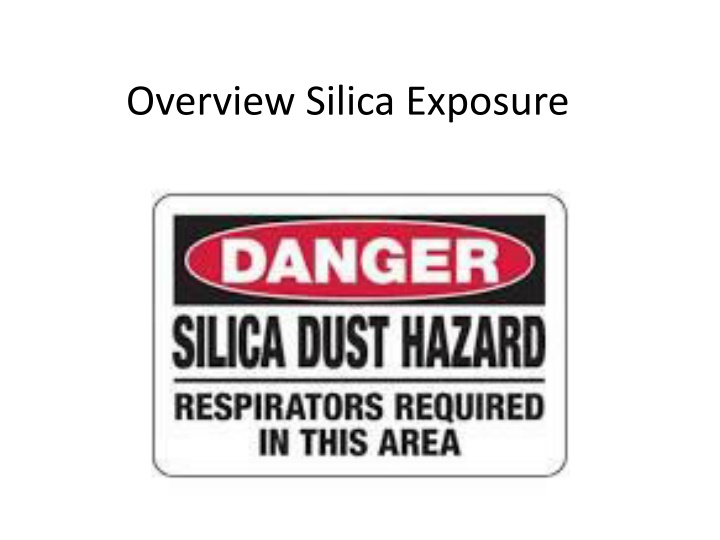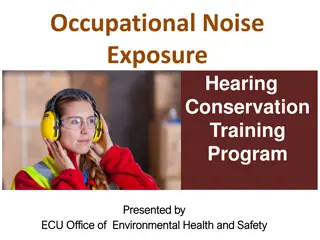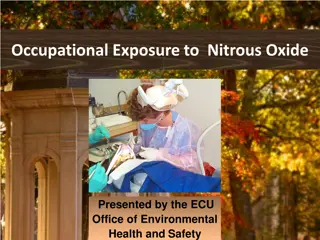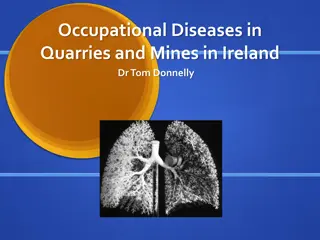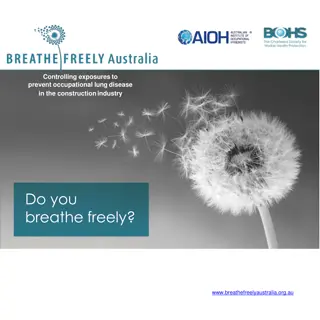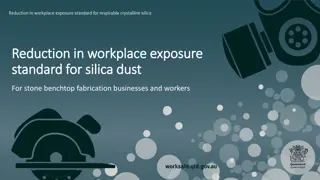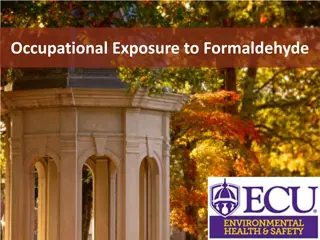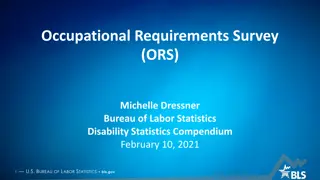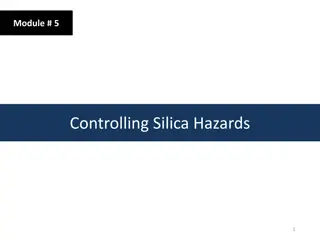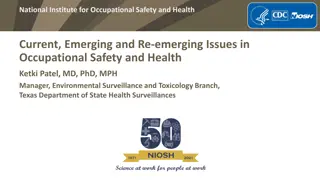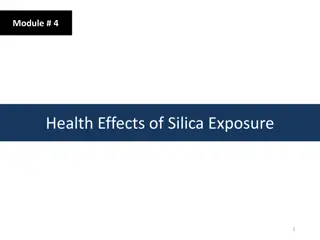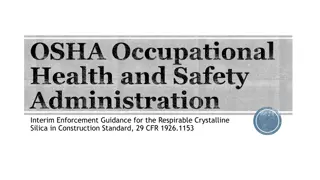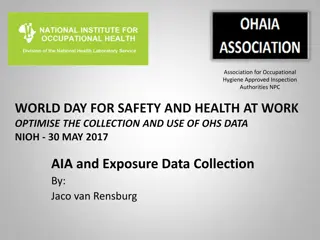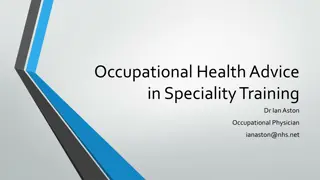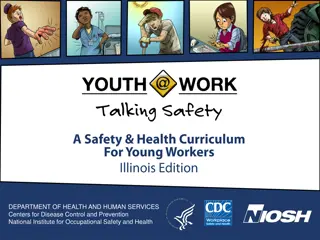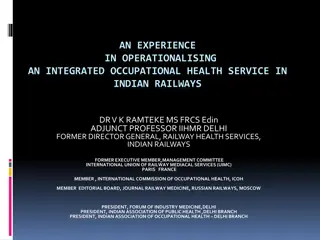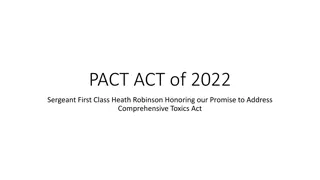Occupational Safety and Health Concerns with Crystalline Silica Exposure
Crystalline silica exposure poses serious health risks, including chronic silicosis, lung cancer, COPD, and kidney diseases. OSHA addresses this issue through programs like NEP, enforcing exposure limits, and requiring safety measures in the construction industry such as respiratory protection and engineering controls. Employers must follow guidelines to protect workers from the harmful effects of silica exposure.
Download Presentation

Please find below an Image/Link to download the presentation.
The content on the website is provided AS IS for your information and personal use only. It may not be sold, licensed, or shared on other websites without obtaining consent from the author.If you encounter any issues during the download, it is possible that the publisher has removed the file from their server.
You are allowed to download the files provided on this website for personal or commercial use, subject to the condition that they are used lawfully. All files are the property of their respective owners.
The content on the website is provided AS IS for your information and personal use only. It may not be sold, licensed, or shared on other websites without obtaining consent from the author.
E N D
Presentation Transcript
Exposure and Health Risks Exposure to respirable crystalline silica has been linked to: Chronic Silicosis -10 years of exposure, Accelerated Silicosis - less than 5 years of exposure or Acute Silicosis - less than 2 years, can be several months. Increased levels of lung cancer Chronic Obstructive Pulmonary Disease (COPD) and Renal, kidney and immune system disease s.
How is OSHA addressing exposure to crystalline silica? OSHA has a National Emphasis Program (NEP) for Crystalline Silica exposure to identify, reduce, and eliminate health hazards associated with occupational exposures. OSHA has an established Permissible Exposure Limit, the maximum amount of crystalline silica to which workers may be exposed to during an 8-hour work shift. OSHA requires haz-com training for workers exposed to crystalline silica, and requires a respiratory protection program until engineered controls are implemented.
Construction- Scope All occupational exposures to respirable crystalline silica are covered, unless employee exposure will remain below 25 g/m3 as an 8-hr TWA under any foreseeable conditions. Respiratory protection; Housekeeping; Written exposure assessment; Medical surveillance; Hazard communication; and Recordkeeping.
Engineering and Work Practice Controls Table 1 in the construction standard matches 18 tasks with effective dust control methods and, in some cases, respirator requirements. Employers that fully and properly implement the engineered controls in Table 1 do not have to: Comply with the PEL of Silica in excess of 50ug/m3 over an 8 hour time frame. 1926.1153(d)(1) Conduct exposure assessments for employees engaged in those tasks. 1926.1153(d)(2)(iii)(3)
Assigned Protection Factor (APF) Assigned Protection Factor (APF) is the workplace level of respiratory protection that a respirator or class of respirators is expected to provide to employees when the employer implements a continuing, effective respiratory protection program as specified by this section.
18 Operations under Table 1 Use of walk-behind saw
18 Operations under Table 1 Jackhammers and handheld powered chipping tools
18 Operations under Table 1 Use of rig-mounted earth-drilling rigs for rock and concrete
18 Operations under Table 1 Use of drivable milling machines
18 Operations under Table 1 Rock Crushing
18 Operations under Table 1 Use of heavy equipment during earthmoving
Table 1 Tasks Handheld grinders for mortar removal (tuckpointing) Handheld grinders for other than mortar removal Walk-behind milling machines and floor grinders (2) Small/Large drivable milling machines Crushing machines Heavy equipment and utility vehicles to abrade or fracture silica materials Heavy equipment and utility vehicles for grading and excavating Stationary masonry saws Handheld power saws Handheld power saws for fiber cement board Walk-behind saws Drivable saws Rig-mounted core saws or drills Handheld and stand-mounted drills Dowel drilling rigs for concrete Vehicle-mounted drilling rigs for rock and concrete Jackhammers and handheld powered chipping tools
Who is Engaged with Table 1? Employees are engaged in the task when operating the listed equipment, assisting with the task, or have some responsibility for the completion of the task Employees are not engaged in the task if they are only in the vicinity of a task
Respiratory Protection Requirements on Table 1 Respirators required where exposures above the PEL are likely to persist despite full and proper implementation of the specified engineering and work practice controls Where respirators required, must be used by all employees engaged in the task for entire duration of the task Provisions specify how to determine when respirators are required for an employee engaged in more than one task 16
Control Method 2 Exposure Assessment 1926.1153(d)(2)(i) General. The employer shall assess the exposure of each employee who is or may reasonably be expected to be exposed to respirable crystalline silica at or above the action level in accordance with either the performance option in paragraph (d)(2)(ii) or the scheduled monitoring option in paragraph (d)(2)(iii) of this section. 1926.1153(d)(2)(ii) Performance option. The employer shall assess the 8-hour TWA exposure foreach employee on the basis of any combination of air monitoring data or objective data sufficient to accurately characterize employee exposures to respirable crystalline silica.
Construction Written Exposure Control Plan The plan must describe: Tasks involving exposure to respirable crystalline silica Engineering controls, work practices, and respiratory protection for each task Housekeeping measures used to limit exposure Procedures used to restrict access, when necessary to limit exposures 18
Construction Competent Person Construction employers must designate a competent person to implement the written exposure control plan Competent person is an individual capable of identifying existing and foreseeable respirable crystalline silica hazards, who has authorization to take prompt corrective measures Makes frequent and regular inspection of job sites, materials, and equipment 19
Construction Medical Surveillance Employers must offer medical examinations to workers: Who will be required to wear a respirator under the standard for 30 or more days a year. Employers must offer examinations every three years to workers who continue to be exposed above the trigger Exam includes medical and work history, physical exam, chest X-ray, and pulmonary function test (TB test on initial exam only) 20
Construction Compliance Dates Employers must comply with all requirements (except methods of sample analysis) by June 23, 2017 Compliance with methods of sample analysis required by June 23, 2018 21
Contact Information for On-Site Training Chris Hayes, CIH Kentucky Labor Cabinet Office of Workplace Standards Div. of Education and Training, Health Branch 1047-US HWY 127-S Ste.#4 Frankfort, KY 40601 (502) 229-9884 chris.hayes@ky.gov
For consultative servicesand publications contact: Kimberlee Perry, Assistant Director Department of Workplace Standards Office of Occupational Safety and Health Division of Education and Training 1047 US Highway 127 S, Suite 4 Frankfort, KY 40601 (502) 564-3070 Kentucky Labor Cabinet Home Page: www.labor.ky.gov
